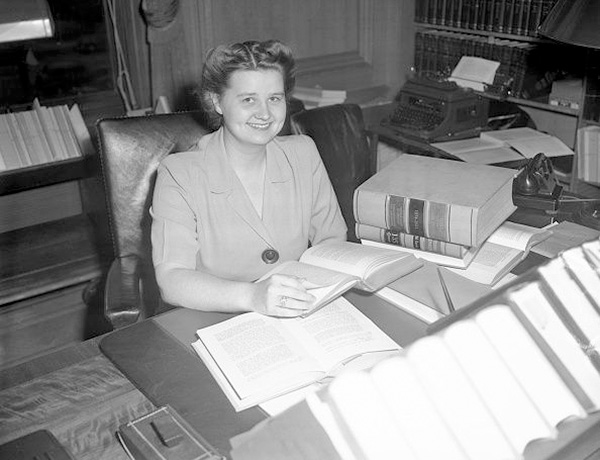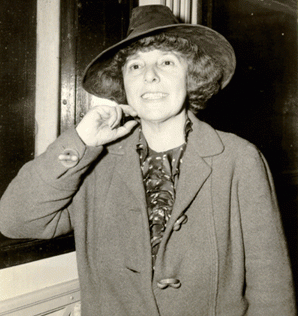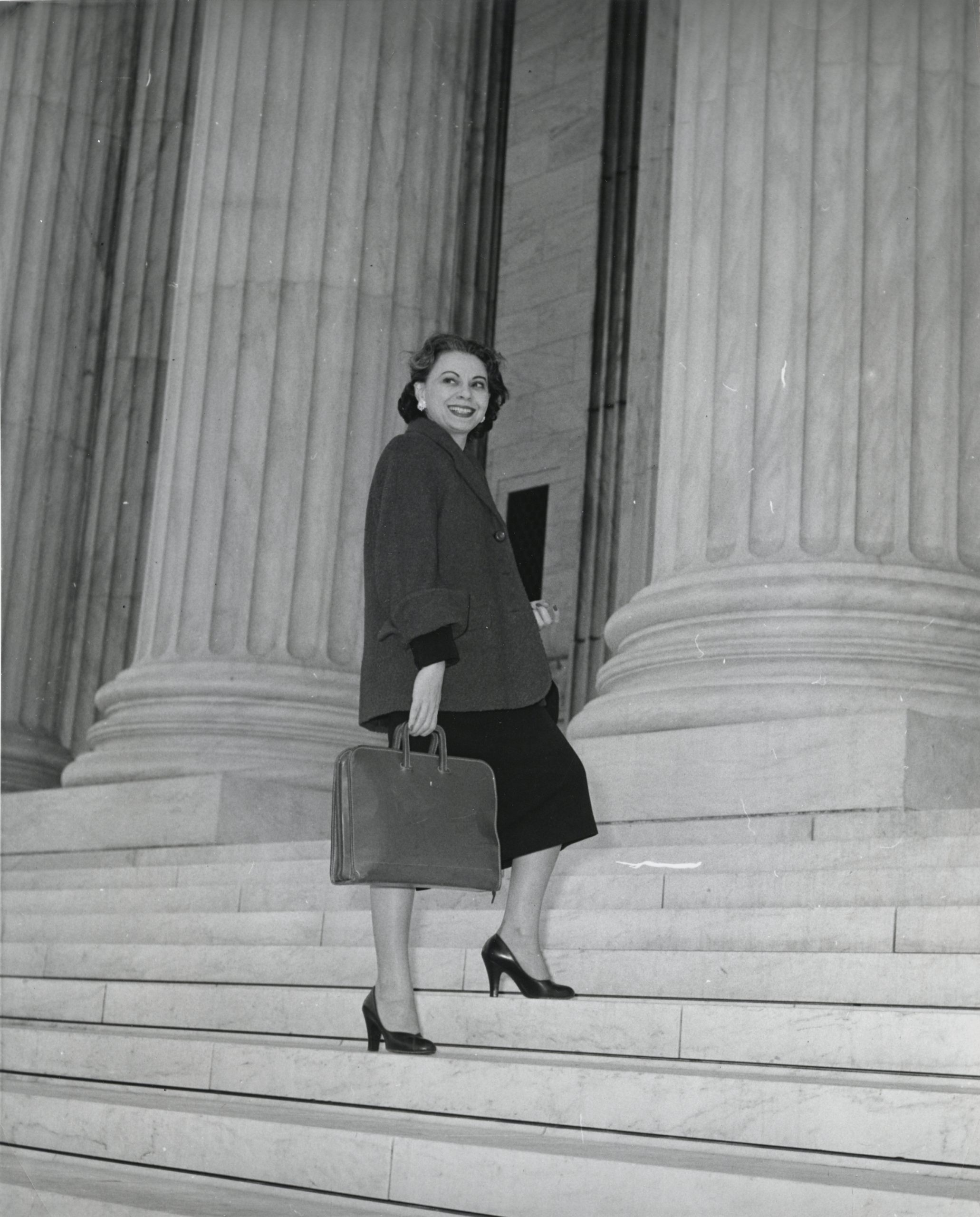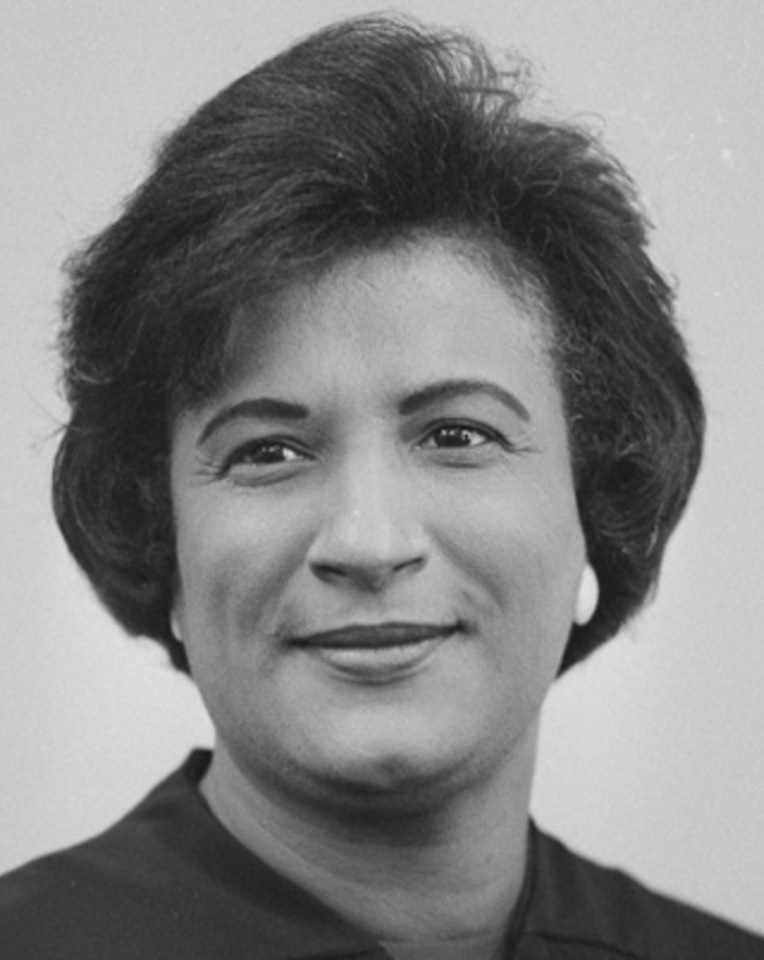Women in Law: 1953-1969
How a small but growing number of women pursued law careers and advocated before the Supreme Court
Background
Working women between 1953 and 1969 were largely excluded from professional work like law. World War II created new economic opportunities for women, but the progress was short-lived. Even so, a small number of women became successful lawyers and argued cases in the Supreme Court of the United States.
World War II expanded economic opportunities for women on the homefront. Between 1941 and 1945, 16 million men served abroad in the U.S. Armed Forces. Their absence at home created a labor shortage, and employers looked to women to fill positions. Factories, especially, needed more workers to meet wartime demands. More than six million women worked as welders, machinists, and riveters—jobs that were typically only open to men. The labor shortage also applied to law. Declining male enrollment led law schools to accept more women during the war. Additionally, unable to find a qualified male candidate, one Supreme Court Justice hired a female law clerk, Lucile Lomen, a first. After Lomen served during the 1944 Supreme Court term, it would be over two decades before the next two women—Margaret J. Corcoran and Martha Alsschuler Field—would be hired.
When the war ended, nearly all women were laid off. The demand for production decreased, and millions of men returned home needing work. Working women returned to pink collar jobs like stenographers, typists, retail sales, teachers, and bookkeepers. Women employed by the Supreme Court during this time were mostly secretaries. Alice O’Donnell, who worked for Justice Tom C. Clark did earn a promotion from secretary to Chambers manager after earning her law degree in 1954.
Supreme Court Advocates
No more than seven women per year argued cases in the Supreme Court during the 1950s, compared to over 200 men per year. Few organizations hired women lawyers, and even fewer selected them to represent clients in the Supreme Court. Generally, nonprofit organizations and the federal government were more open to hiring women than private law practices.
Constance Baker Motley, for example, began her career clerking for the NAACP’s Legal Defense Fund (LDF). Before the LDF hired Motley, she searched for a job on Wall Street and was turned away at every law firm where she applied. With the LDF, she played a vital role in preparing briefs for Brown v. Board of Education (1954), the landmark case that declared school segregation unconstitutional. Though she never received the same recognition as her male colleagues, like Thurgood Marshall, her tireless efforts with the LDF earned her a series of firsts. In 1962, she became the first Black woman to argue before the Supreme Court. She later went on to become the first Black female federal judge and won nine out of the 10 cases she argued before the Supreme Court. Like Judge Motley, Dorothy Kenyon’s work with the Supreme Court began at a nonprofit organization. In addition to her own private practice, Kenyon served on the board of the American Civil Liberties Union (ACLU) for 40 years. She never argued before the Supreme Court, but her contributions to Hoyt v. Florida (1961) and White v. Crook (1965) laid the legal groundwork for applying the Fourteenth Amendment to women’s equality. Catherine Roraback, the only woman in her law school graduating class at Yale, ran a small private practice dedicated to protecting the rights of the “dissenters and the dispossessed.” In her first Supreme Court case, she worked with the Planned Parenthood League of Connecticut in Griswold v. Connecticut (1965), the landmark decision that declared a right to privacy under the Constitution.
Bessie Margolin, on the other hand, represented the U.S. government. She served as assistant solicitor for the Division of Fair Labor Standards from 1963 to 1972. In this role, she fought for America’s wage earners, ensuring appropriate implementation of the Fair Labor Standards Act (FSLA) and the Equal Pay Act. Like Roraback, Margolin was the only woman in her law school graduating class. Margolin understood that being a woman, and Jewish, put her at a disadvantage in her career. She strove to be one of the men, even becoming a regular attendee at poker nights with her male colleagues. Still, she advised her younger sorority sisters that a woman lawyer “must aim to become one of the men, without, however, becoming masculine and overly aggressive in her approach.” Margolin argued 150 cases across every one of the 11 circuits, and 24 cases before the Supreme Court. As a lawyer with the Labor Department, she was responsible for representing the government in cases about the FSLA. The new law kept coming before the Court as the specifics of state minimum wage and maximum working hours policies needed fleshing out. Her colleague in the U.S. Department of Justice, Beatrice Rosenberg, broke this record, arguing 28 times before the Court. Rosenberg was often called upon to handle cases involving illegal search and seizures, which the Court frequently reviewed during the 1960s. Margolin and Rosenberg, along with 1920s advocate Mabel Walker Willebrandt, a lawyer for the Justice Department, argued before the Court more than any other women in the twentieth century.
Though few women worked in law during the 1950s and 1960s, more were on the way. In the 1950s, most U.S. law schools had no more than two women enrolled. By the early 1970s, nearly all law school classes had at least five women. Today, more than half of the law school classes are women.
Discussion Questions
- How did World War II create economic opportunities for women?
- How did women’s economic opportunities change after World War II?
- Why was it significant that Catherine Roraback and Bessie Margolin were the only women in their law school classes?
- How did female lawyers from 1953-1969 advocate for individual rights? Give three examples from the text.
Extension Activity
Read the life stories of Constance Baker Motley, Dorothy Kenyon, Bessie Margolin, and Lucile Lomen. Compare and contrast their experiences.
Sources
Special thanks to the Supreme Court Historical Society’s Director of Publications, Clare Cushman, for her review, feedback, and additional information.
Barbas, Samantha. “Dorothy Kenyon and the Making of Modern Legal Feminism.” Stanford Journal of Civil Rights and Civil Liberties (2009). https://digitalcommons.law.buffalo.edu/cgi/viewcontent.cgi?article=1013&context=journal_articles
“Catherine Roraback.” Connecticut Women’s Hall of Fame. https://www.cwhf.org/inductees/catherine-roraback.
Cushman, Clare. “Fountain Pens and Typewriters: Supreme Court Stenographers and Law Clerks, 1910-1940.” Journal of Supreme Court History 41, no. 1 (2016): 61-63.
Cushman, Clare, ed. “Leading the Way.” Supreme Court Decisions and Women’s Rights. Washington, D.C: CQ Press, 2011. 215-249.
Cushman, Clare. Courtwatchers: Eyewitness Accounts in Supreme Court History. Lanham, MD: Rowman & Littlefield Publishers, Inc: 2011.
Katz, Elizabeth D., Kyle Rozema, and Sarath Sanga. “Women in U.S. Law Schools, 1948–2021.” Journal of Legal Analysis 15, no. 1 (2023): 48–78. https://doi.org/10.1093/jla/laad005
“The Role of Women in World War II.” The National World War II Museum. https://www.nationalww2museum.org/students-teachers/student-resources/research-starters/research-starters-women-world-war-ii.
Trestman, Marlene. “Fair Labor: The Remarkable Life and Legal Career of Bessie Margolin (1909-1996).” Journal of Supreme Court History 37, no. 1 (2012).
Trestman, Marlene. Fair Labor Lawyer: The Remarkable Life of New Deal Attorney and Supreme Court Advocate Bessie Margolin/ Baton Rouge, LA: Louisiana State University Press, 2016.
Featured image: Mrs. Constance B. Motley being sworn in at City Hall. New York Manhattan, 1965. Library of Congress. https://www.loc.gov/item/2009633855/.




